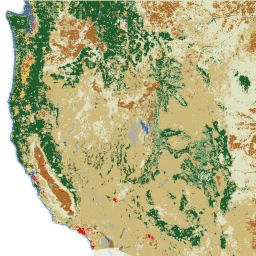
- 数据集可用性
- 2001-01-01T00:00:00Z–2019-01-01T00:00:00Z
- 数据集提供商
- 美国地质调查局 (USGS)
- 标签
说明
NLCD(美国国家土地覆盖数据库)是一个基于 Landsat 的 30 米土地覆盖数据库,涵盖 8 个时间段(2001 年、2004 年、2006 年、2008 年、2011 年、2013 年、2016 年和 2019 年)。您还可以点击此处查看 2021 年的第九个周期。这些图片依靠不透水层数据层来确定城市类,依靠决策树分类来确定其余类。
此数据集包含每个历元的美国大陆图像。 阿拉斯加、夏威夷和波多黎各的数据可在之前的 2016 年 NLCD 版本中找到。
NLCD 产品由多分辨率土地特征 (MRLC) 联盟创建,该联盟是由美国地质调查局领导的联邦机构合作伙伴关系。
频段
像素大小
30 米
频段
| 名称 | 单位 | 最小值 | 最大值 | 像素尺寸 | 说明 |
|---|---|---|---|---|---|
landcover |
11 | 95 | 米 | 所有图片均包含产品图例中所述的地表覆盖分类方案。图例也可作为每张图片的元数据提供。产品图例中的类别如下所示。 |
|
impervious |
% | 0 | 100 | 米 | 已开发的不透水表面覆盖的像素百分比。 |
impervious_descriptor |
1 | 12 | 米 | 定义哪些不透水层像素是道路,并为不是道路的不透水像素提供最佳拟合说明。 |
土地覆盖类别表
| 值 | 颜色 | 说明 |
|---|---|---|
| 11 | #466b9f | 开阔水域:开阔水域区域,植被或土壤覆盖率通常低于 25%。 |
| 12 | #d1def8 | 多年生冰/雪:以多年生冰和/或雪覆盖为特征的区域,一般占总覆盖面积的 25% 以上。 |
| 21 | #dec5c5 | 已开发的开阔空间:混合使用了一些建筑材料,但主要为草坪草等植被的区域。不透水地表占总覆盖面积的比例不到 20%。这些区域最常见的是大面积的单户住宅、公园、高尔夫球场,以及为休闲、侵蚀控制或美观目的而在已开发环境中种植的植被。 |
| 22 | #d99282 | 已开发,低强度:混合了建筑材料和植被的区域。不透水地表占总覆盖面积的 20% 至 49%。这些区域最常见的是独栋住宅。 |
| 23 | #eb0000 | 已开发,中等强度:混合了建筑材料和植被的区域。不透水地表占总覆盖面积的 50% 至 79%。这些区域最常见的是独栋住宅。 |
| 24 | #ab0000 | 高度发达:人口或工作人口密度较高的发达地区。例如公寓楼、排屋和商业/工业建筑。不透水地表占总覆盖面积的 80% 至 100%。 |
| 31 | #b3ac9f | 贫瘠土地(岩石/沙土/黏土):基岩、荒漠砾石、陡坡、碎石坡、滑坡、火山物质、冰川碎屑、沙丘、露天矿、砂砾坑和其他土质物质堆积区。一般来说,植被覆盖率不到总覆盖率的 15%。 |
| 41 | #68ab5f | 落叶林:以树木为主的区域,树木高度通常超过 5 米,占植被总覆盖面积的 20% 以上。超过 75% 的树种会同时落叶,以应对季节变化。 |
| 42 | #1c5f2c | 常绿森林:以树木为主的区域,树木高度通常超过 5 米,占植被总覆盖面积的 20% 以上。超过 75% 的树种全年都保持着绿叶。树冠上永远不会没有绿色树叶。 |
| 43 | #b5c58f | 混交林:以树木为主的区域,树木高度通常超过 5 米,占植被总覆盖面积的 20% 以上。落叶树种和常绿树种均未超过总树木覆盖率的 75%。 |
| 51 | #af963c | 矮灌丛:仅限阿拉斯加地区,以高度低于 20 厘米的灌木为主,灌木冠层通常占总植被的 20% 以上。这种类型的湿地通常与草类、莎草类、草本植物和非维管植物相关联。 |
| 52 | #ccb879 | |
| 71 | #dfdfc2 | |
| 72 | #d1d182 | |
| 73 | #a3cc51 | |
| 74 | #82ba9e | 苔藓:仅有苔藓的阿拉斯加地区,苔藓通常占总植被的 80% 以上。 |
| 81 | #dcd939 | |
| 82 | #ab6c28 | 耕种的作物:用于生产一年生作物的区域,例如玉米、大豆、蔬菜、烟草和棉花,以及多年生木本作物,例如果园和葡萄园。农作物植被占总植被的 20% 以上。此类还包括所有正在耕种的土地。 |
| 90 | #b8d9eb | 木本湿地:森林或灌木丛植被占植被覆盖率 20% 以上的区域,土壤或基质会定期被水浸透或覆盖。 |
| 95 | #6c9fb8 | 挺水草本湿地:多年生草本植被占植被覆盖率 80% 以上的区域,土壤或基质会定期被水浸透或覆盖。 |
impervious_descriptor 类表
| 值 | 颜色 | 说明 |
|---|---|---|
| 0 | #000000 | 未分类。 |
| 20 | #ff0000 | 主干道。州际公路和其他主要道路。像素源自 2018 年的 NavStreets 街道数据。 |
| 21 | #ffff00 | 小路。非州际高速公路。像素源自 2018 年的 NavStreets 街道数据。 |
| 22 | #0000ff | 三级道路。任何双车道道路。像素源自 2018 年 NavStreets 街道数据。 |
| 23 | #ffffff | 变细的道路。通常未铺砌的小型三级道路,已从土地覆盖数据中移除,但仍属于不透水地表产品的一部分。像素源自 2018 年的 NavStreets 街道数据。 |
| 24 | #ffc0c5 | 非道路非能源不透水面。通常不是道路或能源生产的已开发区域;包括住宅/商业/工业区、公园和高尔夫球场。 |
| 25 | #eb82eb | Microsoft 建筑。未在 NLCD 不透水过程中捕获,且未包含在非道路不透水地表类别中的建筑物。从 Microsoft 美国建筑轮廓数据集派生的像素。 |
| 26 | #9f1feb | LCMAP 不透水。来自 LCMAP 的不透水像素,用于填补道路从旧版 NLCD 更新后留下的空白。 |
| 27 | #40dfd0 | 风力涡轮机。像素源自美国风力涡轮机数据集,访问日期为 2020 年 1 月 9 日。 |
| 28 | #79ff00 | 井垫。像素源自橡树岭国家实验室 2019 年的“油气井”数据集。 |
| 29 | #005f00 | 其他能源生产。之前被确定为钻井平台和风力涡轮机并与 Landfire 项目协调分类的区域。 |
图片属性
图片属性
| 名称 | 类型 | 说明 |
|---|---|---|
| landcover_class_names | 双精度 | 土地覆盖类别名称 |
| landcover_class_palette | 双精度 | 土地覆盖类别调色板 |
| landcover_class_values | 双精度 | 土地覆盖类别值 |
| impervious_descriptor_class_names | 双精度 | Impervious 描述符类名称 |
| impervious_descriptor_class_palette | 双精度 | 不透水描述符类调色板 |
| impervious_descriptor_class_values | 双精度 | Impervious 描述符类值 |
使用条款
使用条款
美国地质调查局 (USGS) 的大部分信息都是联邦政府创建的数据,因此属于公共领域,可以不受版权限制地使用、转移或复制。 如需详细了解将美国地质调查局 (USGS) 视为信息来源时如何致谢或注明出处,请参阅相关文档。
引用
Dewitz, J.,以及美国地质调查局,2021 年,国家土地覆盖数据库 (NLCD) 2019 年产品(版本 2.0,2021 年 6 月):美国地质调查局数据发布,doi:10.5066/P9KZCM54
DOI
使用 Earth Engine 探索
代码编辑器 (JavaScript)
// Import the NLCD collection. var dataset = ee.ImageCollection('USGS/NLCD_RELEASES/2019_REL/NLCD'); // The collection contains images for multiple years and regions in the USA. print('Products:', dataset.aggregate_array('system:index')); // Filter the collection to the 2016 product. var nlcd2016 = dataset.filter(ee.Filter.eq('system:index', '2016')).first(); // Each product has multiple bands for describing aspects of land cover. print('Bands:', nlcd2016.bandNames()); // Select the land cover band. var landcover = nlcd2016.select('landcover'); // Display land cover on the map. Map.setCenter(-95, 38, 5); Map.addLayer(landcover, null, 'Landcover');
